Case Studies: Ethical Issues in Train Disasters and Analysis
VerifiedAdded on 2023/06/04
|20
|5189
|389
Report
AI Summary
This report presents a critical analysis of ethical issues arising from train disasters, focusing on two case studies: the Waterfall rail incident in Australia and the Jnaneswari Express derailment in India. The report examines the incidents, their causes, and the systemic failures that contributed to them, including breaches of professional codes of conduct and inadequate safety measures. It details the specific issues in each case, such as driver negligence, technical problems, and lack of proper training. The report then compares the two incidents, highlighting similarities and differences in the contributing factors and the implemented changes. Finally, it evaluates the ethical implications, including the responsibilities of various parties and the importance of adhering to professional codes of conduct to prevent such tragedies. The report provides a comprehensive overview of the ethical dimensions of train disasters, offering insights into the causes, consequences, and potential preventative measures.

Running head: ETHICAL ISSUES IN TRAIN DISASTERS
ETHICAL ISSUES IN TRAIN DISASTERS
Name of student:
Name of university:
Author’s note:
ETHICAL ISSUES IN TRAIN DISASTERS
Name of student:
Name of university:
Author’s note:
Paraphrase This Document
Need a fresh take? Get an instant paraphrase of this document with our AI Paraphraser
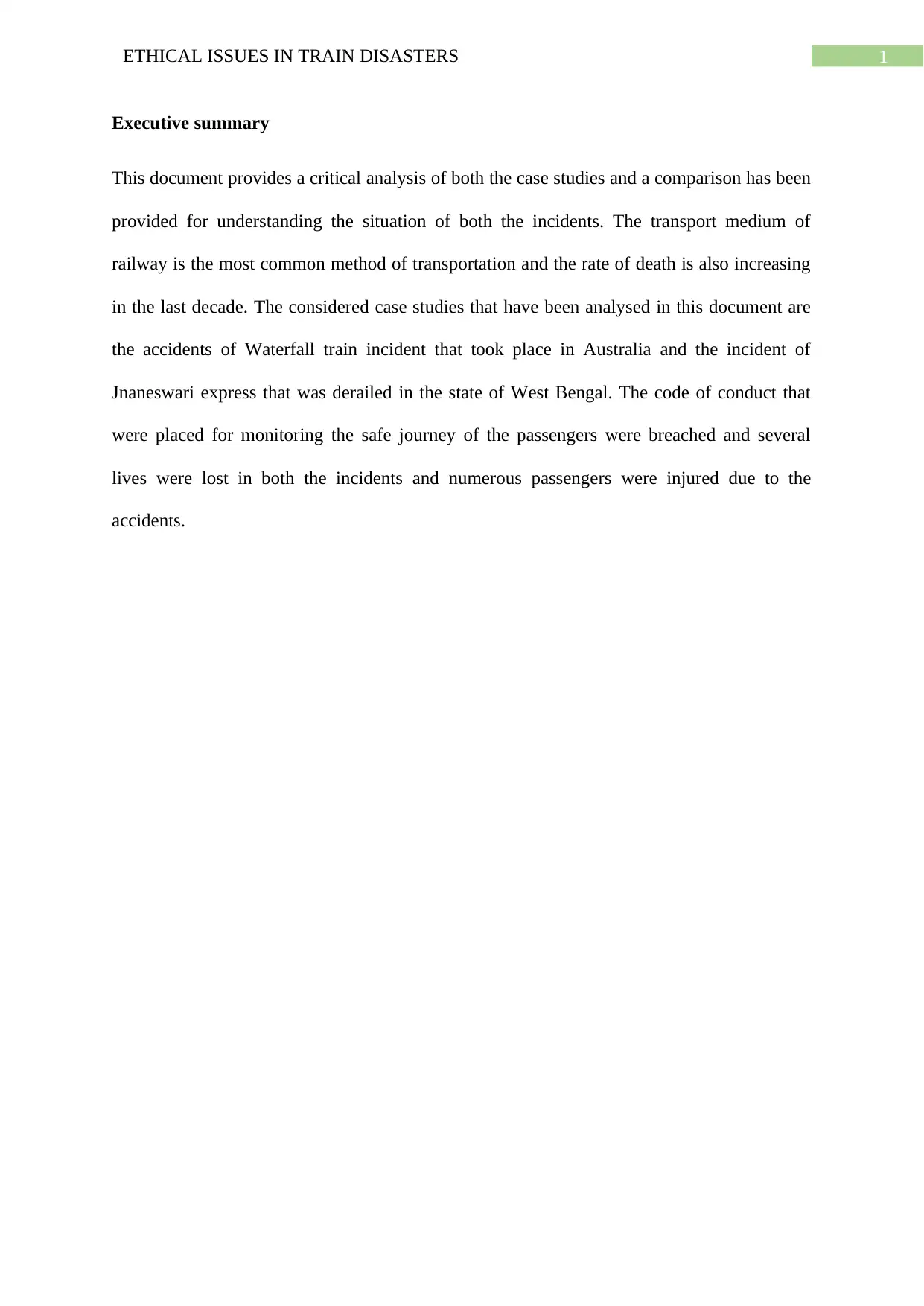
1ETHICAL ISSUES IN TRAIN DISASTERS
Executive summary
This document provides a critical analysis of both the case studies and a comparison has been
provided for understanding the situation of both the incidents. The transport medium of
railway is the most common method of transportation and the rate of death is also increasing
in the last decade. The considered case studies that have been analysed in this document are
the accidents of Waterfall train incident that took place in Australia and the incident of
Jnaneswari express that was derailed in the state of West Bengal. The code of conduct that
were placed for monitoring the safe journey of the passengers were breached and several
lives were lost in both the incidents and numerous passengers were injured due to the
accidents.
Executive summary
This document provides a critical analysis of both the case studies and a comparison has been
provided for understanding the situation of both the incidents. The transport medium of
railway is the most common method of transportation and the rate of death is also increasing
in the last decade. The considered case studies that have been analysed in this document are
the accidents of Waterfall train incident that took place in Australia and the incident of
Jnaneswari express that was derailed in the state of West Bengal. The code of conduct that
were placed for monitoring the safe journey of the passengers were breached and several
lives were lost in both the incidents and numerous passengers were injured due to the
accidents.
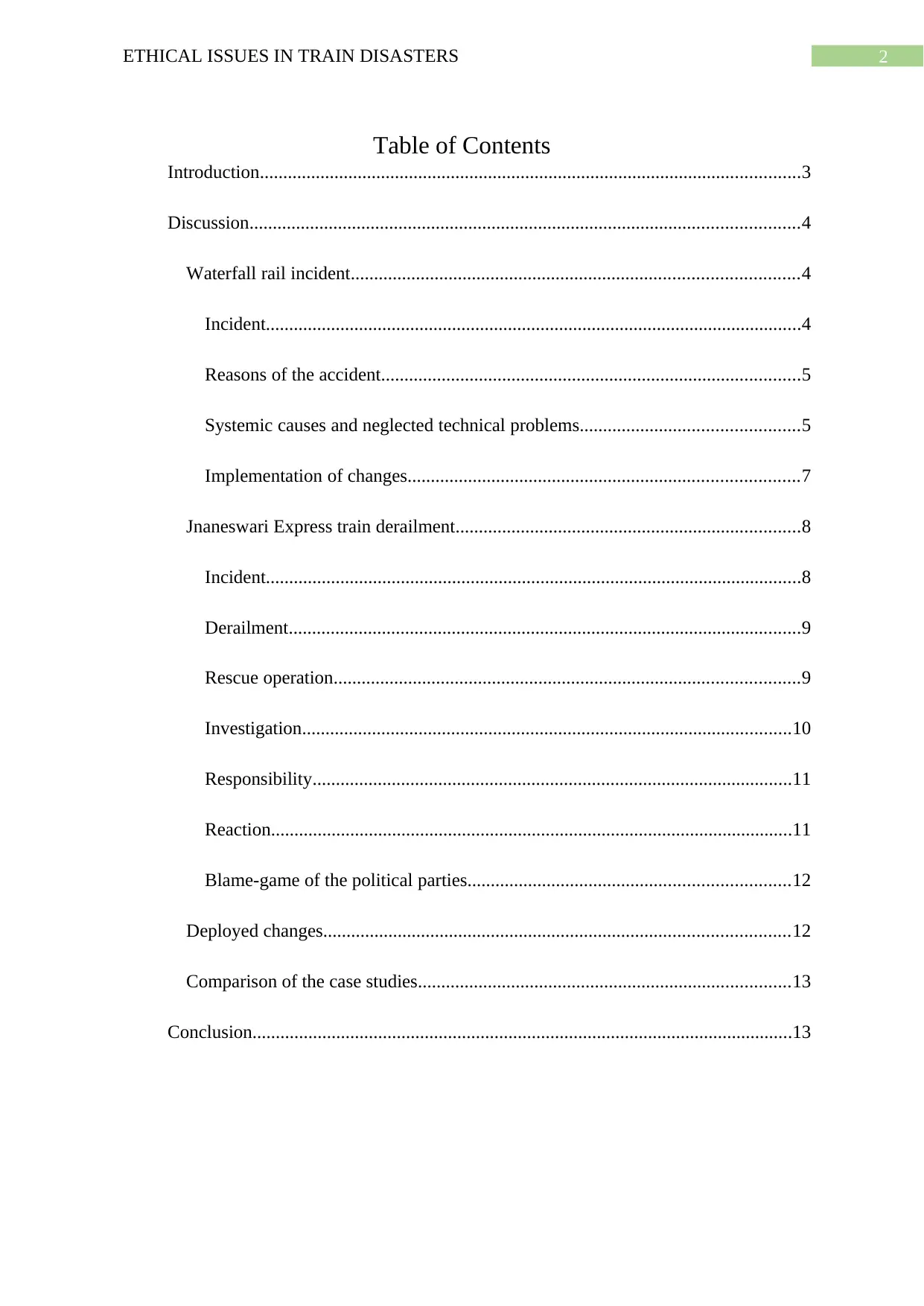
2ETHICAL ISSUES IN TRAIN DISASTERS
Table of Contents
Introduction....................................................................................................................3
Discussion......................................................................................................................4
Waterfall rail incident................................................................................................4
Incident...................................................................................................................4
Reasons of the accident..........................................................................................5
Systemic causes and neglected technical problems...............................................5
Implementation of changes....................................................................................7
Jnaneswari Express train derailment..........................................................................8
Incident...................................................................................................................8
Derailment..............................................................................................................9
Rescue operation....................................................................................................9
Investigation.........................................................................................................10
Responsibility.......................................................................................................11
Reaction................................................................................................................11
Blame-game of the political parties.....................................................................12
Deployed changes....................................................................................................12
Comparison of the case studies................................................................................13
Conclusion....................................................................................................................13
Table of Contents
Introduction....................................................................................................................3
Discussion......................................................................................................................4
Waterfall rail incident................................................................................................4
Incident...................................................................................................................4
Reasons of the accident..........................................................................................5
Systemic causes and neglected technical problems...............................................5
Implementation of changes....................................................................................7
Jnaneswari Express train derailment..........................................................................8
Incident...................................................................................................................8
Derailment..............................................................................................................9
Rescue operation....................................................................................................9
Investigation.........................................................................................................10
Responsibility.......................................................................................................11
Reaction................................................................................................................11
Blame-game of the political parties.....................................................................12
Deployed changes....................................................................................................12
Comparison of the case studies................................................................................13
Conclusion....................................................................................................................13
⊘ This is a preview!⊘
Do you want full access?
Subscribe today to unlock all pages.

Trusted by 1+ million students worldwide

3ETHICAL ISSUES IN TRAIN DISASTERS
Paraphrase This Document
Need a fresh take? Get an instant paraphrase of this document with our AI Paraphraser

4ETHICAL ISSUES IN TRAIN DISASTERS
Introduction
This report aims to analyse two different train accidents that took place in Australia
and in India. The considered case study from Australia is the incident of Waterfall rail
incident that took place in the Waterfall, Australia. The second considered case study is the
case study of the Jnaneswari Express that occurred in India, which caused the derailment of
an express train in the state of West Bengal. A detailed discussion of the incident is provided
for both the cases. The cause of the incident in both the case are stated clearly in this report.
The problems that led to both the incidents are discussed in this report. The changes that were
implemented in both the case scenarios have been stated in this report. Finally, a comparison
of both the case studies has been provided in this report. Lastly, this report concludes with an
appropriate conclusion for this report.
Train accident is the type of disaster that involves one or more trains. The majority of
the train accidents occur due to the result of miscommunication or when two trains meet on
the same track or any kind of derailment occurs (Kenny 2015).
Introduction
This report aims to analyse two different train accidents that took place in Australia
and in India. The considered case study from Australia is the incident of Waterfall rail
incident that took place in the Waterfall, Australia. The second considered case study is the
case study of the Jnaneswari Express that occurred in India, which caused the derailment of
an express train in the state of West Bengal. A detailed discussion of the incident is provided
for both the cases. The cause of the incident in both the case are stated clearly in this report.
The problems that led to both the incidents are discussed in this report. The changes that were
implemented in both the case scenarios have been stated in this report. Finally, a comparison
of both the case studies has been provided in this report. Lastly, this report concludes with an
appropriate conclusion for this report.
Train accident is the type of disaster that involves one or more trains. The majority of
the train accidents occur due to the result of miscommunication or when two trains meet on
the same track or any kind of derailment occurs (Kenny 2015).

5ETHICAL ISSUES IN TRAIN DISASTERS
Discussion
Waterfall rail incident
The accident of Waterfall rail was the train related accident that occurred on 31st
January 2003, near Waterfall, New South Wales, Australia. The derailment of the train took
place that killed seven people including the train driver (Bahr 2014).
Incident
The day when the disaster occurred, a Tangara interurban train service, set G7 that
came from the Sydney Central Station that departed from the station of Sydney Waterfall
station stirring south headed for Port Kembla station through Wollongong (Quigley and
Quigley 2013). Approximately, in the morning, the control of the train was lost due to the
condition of heart attack faced by the driver. Due to this reason, the train was travelling at 73
mph as it came close to a curve into the tracks over a minor cutting. The rating of the curve is
for speed that is no more than 37 mph. The derailment of the train happened, that made the
train to overturn and it collided with the rocky walls residing in the cutting in an isolated area
that is south of the station. It was discovered several heavy lifting equipment had to be
carried by the rescuers for atleast 1.5 km for reaching the site (Sellers 2014). Two carriages
were brutally impaired and two of the carriages flipped on their side and were damaged.
Including the seven losses, several more passengers suffered injuries.
After rigorous inquiry, it was discovered that the utilisation of the deadman’s brake
was not done properly. The solicitor of the guard of the train stated that the guard fell in sleep
for about 30 seconds and during this time, the accident happened (Traub and Fraser 2013).
The experienced investigator of the human factors accident discovered that the culture of the
organisation had the driver determinedly in charge that made the driver psychologically
increasingly difficult to act instantly.
Discussion
Waterfall rail incident
The accident of Waterfall rail was the train related accident that occurred on 31st
January 2003, near Waterfall, New South Wales, Australia. The derailment of the train took
place that killed seven people including the train driver (Bahr 2014).
Incident
The day when the disaster occurred, a Tangara interurban train service, set G7 that
came from the Sydney Central Station that departed from the station of Sydney Waterfall
station stirring south headed for Port Kembla station through Wollongong (Quigley and
Quigley 2013). Approximately, in the morning, the control of the train was lost due to the
condition of heart attack faced by the driver. Due to this reason, the train was travelling at 73
mph as it came close to a curve into the tracks over a minor cutting. The rating of the curve is
for speed that is no more than 37 mph. The derailment of the train happened, that made the
train to overturn and it collided with the rocky walls residing in the cutting in an isolated area
that is south of the station. It was discovered several heavy lifting equipment had to be
carried by the rescuers for atleast 1.5 km for reaching the site (Sellers 2014). Two carriages
were brutally impaired and two of the carriages flipped on their side and were damaged.
Including the seven losses, several more passengers suffered injuries.
After rigorous inquiry, it was discovered that the utilisation of the deadman’s brake
was not done properly. The solicitor of the guard of the train stated that the guard fell in sleep
for about 30 seconds and during this time, the accident happened (Traub and Fraser 2013).
The experienced investigator of the human factors accident discovered that the culture of the
organisation had the driver determinedly in charge that made the driver psychologically
increasingly difficult to act instantly.
⊘ This is a preview!⊘
Do you want full access?
Subscribe today to unlock all pages.

Trusted by 1+ million students worldwide
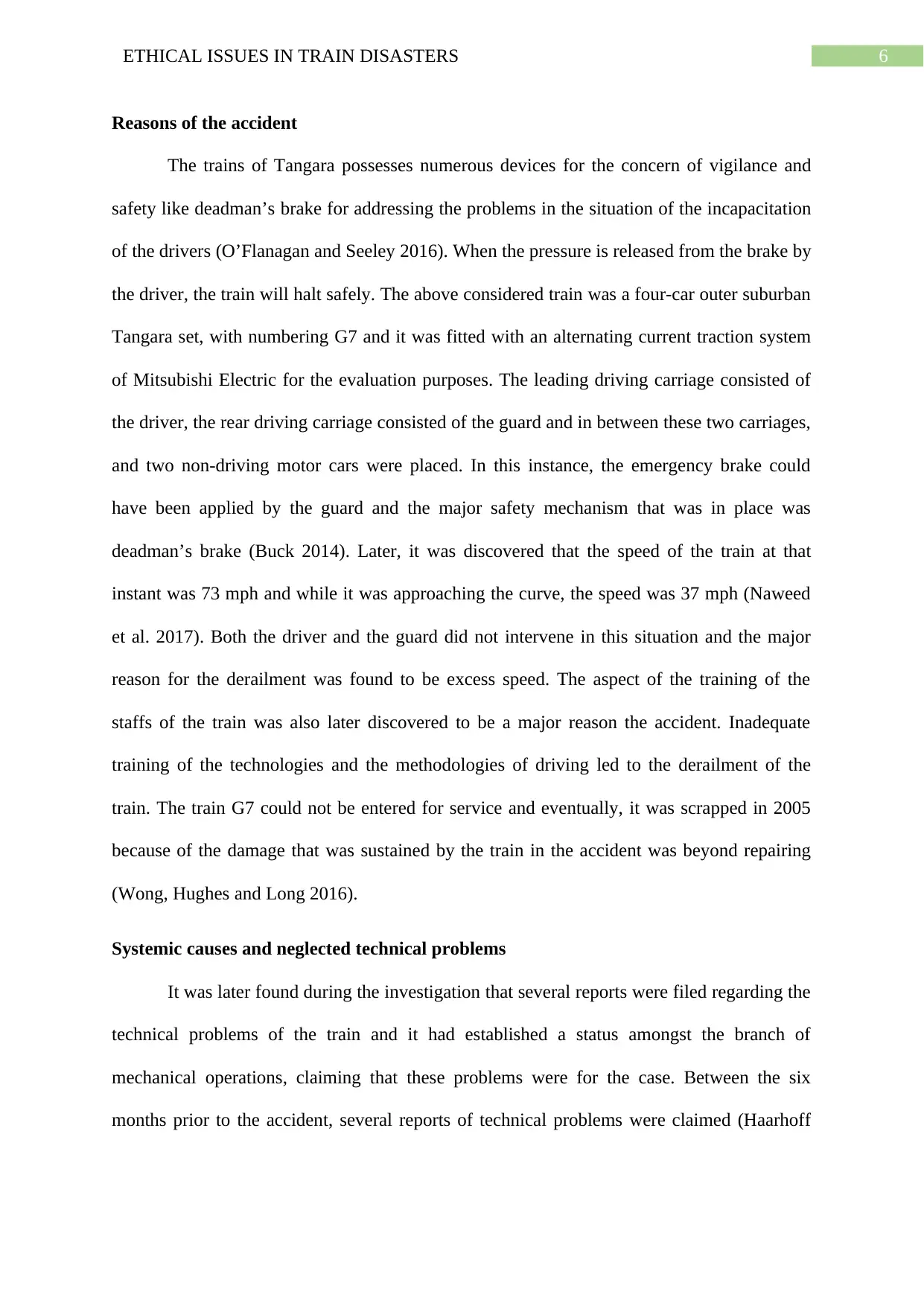
6ETHICAL ISSUES IN TRAIN DISASTERS
Reasons of the accident
The trains of Tangara possesses numerous devices for the concern of vigilance and
safety like deadman’s brake for addressing the problems in the situation of the incapacitation
of the drivers (O’Flanagan and Seeley 2016). When the pressure is released from the brake by
the driver, the train will halt safely. The above considered train was a four-car outer suburban
Tangara set, with numbering G7 and it was fitted with an alternating current traction system
of Mitsubishi Electric for the evaluation purposes. The leading driving carriage consisted of
the driver, the rear driving carriage consisted of the guard and in between these two carriages,
and two non-driving motor cars were placed. In this instance, the emergency brake could
have been applied by the guard and the major safety mechanism that was in place was
deadman’s brake (Buck 2014). Later, it was discovered that the speed of the train at that
instant was 73 mph and while it was approaching the curve, the speed was 37 mph (Naweed
et al. 2017). Both the driver and the guard did not intervene in this situation and the major
reason for the derailment was found to be excess speed. The aspect of the training of the
staffs of the train was also later discovered to be a major reason the accident. Inadequate
training of the technologies and the methodologies of driving led to the derailment of the
train. The train G7 could not be entered for service and eventually, it was scrapped in 2005
because of the damage that was sustained by the train in the accident was beyond repairing
(Wong, Hughes and Long 2016).
Systemic causes and neglected technical problems
It was later found during the investigation that several reports were filed regarding the
technical problems of the train and it had established a status amongst the branch of
mechanical operations, claiming that these problems were for the case. Between the six
months prior to the accident, several reports of technical problems were claimed (Haarhoff
Reasons of the accident
The trains of Tangara possesses numerous devices for the concern of vigilance and
safety like deadman’s brake for addressing the problems in the situation of the incapacitation
of the drivers (O’Flanagan and Seeley 2016). When the pressure is released from the brake by
the driver, the train will halt safely. The above considered train was a four-car outer suburban
Tangara set, with numbering G7 and it was fitted with an alternating current traction system
of Mitsubishi Electric for the evaluation purposes. The leading driving carriage consisted of
the driver, the rear driving carriage consisted of the guard and in between these two carriages,
and two non-driving motor cars were placed. In this instance, the emergency brake could
have been applied by the guard and the major safety mechanism that was in place was
deadman’s brake (Buck 2014). Later, it was discovered that the speed of the train at that
instant was 73 mph and while it was approaching the curve, the speed was 37 mph (Naweed
et al. 2017). Both the driver and the guard did not intervene in this situation and the major
reason for the derailment was found to be excess speed. The aspect of the training of the
staffs of the train was also later discovered to be a major reason the accident. Inadequate
training of the technologies and the methodologies of driving led to the derailment of the
train. The train G7 could not be entered for service and eventually, it was scrapped in 2005
because of the damage that was sustained by the train in the accident was beyond repairing
(Wong, Hughes and Long 2016).
Systemic causes and neglected technical problems
It was later found during the investigation that several reports were filed regarding the
technical problems of the train and it had established a status amongst the branch of
mechanical operations, claiming that these problems were for the case. Between the six
months prior to the accident, several reports of technical problems were claimed (Haarhoff
Paraphrase This Document
Need a fresh take? Get an instant paraphrase of this document with our AI Paraphraser
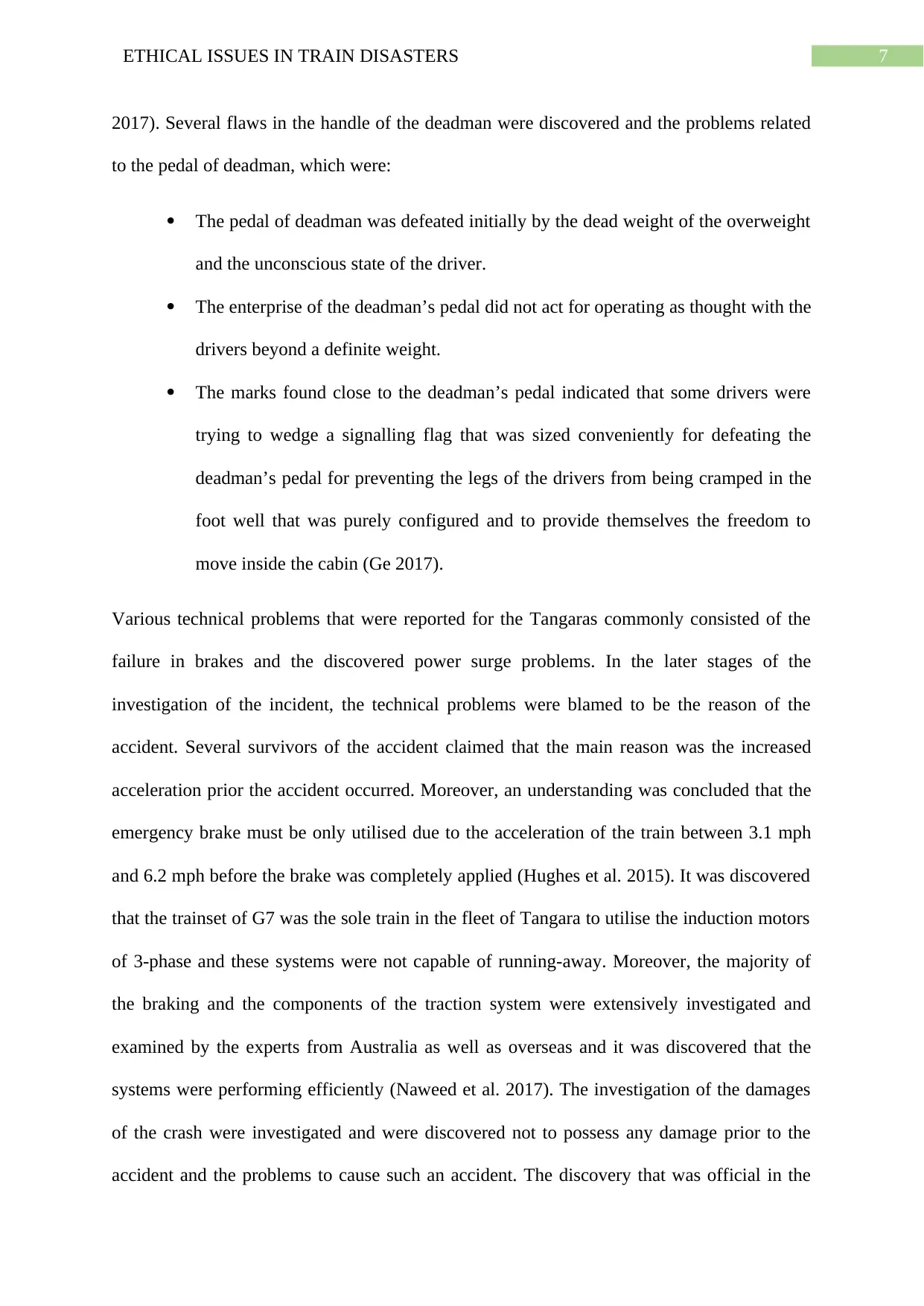
7ETHICAL ISSUES IN TRAIN DISASTERS
2017). Several flaws in the handle of the deadman were discovered and the problems related
to the pedal of deadman, which were:
The pedal of deadman was defeated initially by the dead weight of the overweight
and the unconscious state of the driver.
The enterprise of the deadman’s pedal did not act for operating as thought with the
drivers beyond a definite weight.
The marks found close to the deadman’s pedal indicated that some drivers were
trying to wedge a signalling flag that was sized conveniently for defeating the
deadman’s pedal for preventing the legs of the drivers from being cramped in the
foot well that was purely configured and to provide themselves the freedom to
move inside the cabin (Ge 2017).
Various technical problems that were reported for the Tangaras commonly consisted of the
failure in brakes and the discovered power surge problems. In the later stages of the
investigation of the incident, the technical problems were blamed to be the reason of the
accident. Several survivors of the accident claimed that the main reason was the increased
acceleration prior the accident occurred. Moreover, an understanding was concluded that the
emergency brake must be only utilised due to the acceleration of the train between 3.1 mph
and 6.2 mph before the brake was completely applied (Hughes et al. 2015). It was discovered
that the trainset of G7 was the sole train in the fleet of Tangara to utilise the induction motors
of 3-phase and these systems were not capable of running-away. Moreover, the majority of
the braking and the components of the traction system were extensively investigated and
examined by the experts from Australia as well as overseas and it was discovered that the
systems were performing efficiently (Naweed et al. 2017). The investigation of the damages
of the crash were investigated and were discovered not to possess any damage prior to the
accident and the problems to cause such an accident. The discovery that was official in the
2017). Several flaws in the handle of the deadman were discovered and the problems related
to the pedal of deadman, which were:
The pedal of deadman was defeated initially by the dead weight of the overweight
and the unconscious state of the driver.
The enterprise of the deadman’s pedal did not act for operating as thought with the
drivers beyond a definite weight.
The marks found close to the deadman’s pedal indicated that some drivers were
trying to wedge a signalling flag that was sized conveniently for defeating the
deadman’s pedal for preventing the legs of the drivers from being cramped in the
foot well that was purely configured and to provide themselves the freedom to
move inside the cabin (Ge 2017).
Various technical problems that were reported for the Tangaras commonly consisted of the
failure in brakes and the discovered power surge problems. In the later stages of the
investigation of the incident, the technical problems were blamed to be the reason of the
accident. Several survivors of the accident claimed that the main reason was the increased
acceleration prior the accident occurred. Moreover, an understanding was concluded that the
emergency brake must be only utilised due to the acceleration of the train between 3.1 mph
and 6.2 mph before the brake was completely applied (Hughes et al. 2015). It was discovered
that the trainset of G7 was the sole train in the fleet of Tangara to utilise the induction motors
of 3-phase and these systems were not capable of running-away. Moreover, the majority of
the braking and the components of the traction system were extensively investigated and
examined by the experts from Australia as well as overseas and it was discovered that the
systems were performing efficiently (Naweed et al. 2017). The investigation of the damages
of the crash were investigated and were discovered not to possess any damage prior to the
accident and the problems to cause such an accident. The discovery that was official in the

8ETHICAL ISSUES IN TRAIN DISASTERS
accident claimed that the underdevelopment of the safety culture was also a reason for the
accident. The cityrail were also criticised for not implementing proper safety and security
issues that resulted in the accident. The code of professional conduct was not properly
maintained by the authority and the drivers. The integrity of the drivers can be questioned and
the duty that a driver possess for the safe journey for the passengers was also breached
(Grover and Pancholi 2014).
Before this derailment, neither the training nor the procedures were properly mandated by the
guard for exercising complete control over the train speed by utilising the emergency brake
pipe cock. Separately from making the driver the sole operator of the train, the placed
emergency brake pipe cock was discovered to not offer the similar degree of control over the
automatic brake as a proper brake valve (Hart 2013). The agreement amongst the crews of the
train was that the sudden application of emergency brake from the rear could cause a
breakaway and some evidence was discovered from the previous accidents that could validate
the opinions, however these aspects were not involved in the developed multi-unit design of
the Tangara train.
Implementation of changes
All the trains of CityRail have been modified with the implementation of safety
failure. Additionally, along with the foot pedal and the deadman handle, the trains are fixed
with task linked vigilance, which rearranges a timer each time certain controls are activated
by the driver (Bradt et al. 2015). If no changes happens in the control, a fluctuating lamp and
then a buzzer sound and then the driver is needed to acknowledge a button of vigilance. If the
controls are not being utilised by the driver of the train for acknowledging the alarm of
vigilance, the vigilance system is activated and creates an emergency application of brake
(Michel and Gardiner 2014). For monitoring the actions of the guard and the driver and the
speed of the train, the trains are added with data loggers. The G7 was also implemented with
accident claimed that the underdevelopment of the safety culture was also a reason for the
accident. The cityrail were also criticised for not implementing proper safety and security
issues that resulted in the accident. The code of professional conduct was not properly
maintained by the authority and the drivers. The integrity of the drivers can be questioned and
the duty that a driver possess for the safe journey for the passengers was also breached
(Grover and Pancholi 2014).
Before this derailment, neither the training nor the procedures were properly mandated by the
guard for exercising complete control over the train speed by utilising the emergency brake
pipe cock. Separately from making the driver the sole operator of the train, the placed
emergency brake pipe cock was discovered to not offer the similar degree of control over the
automatic brake as a proper brake valve (Hart 2013). The agreement amongst the crews of the
train was that the sudden application of emergency brake from the rear could cause a
breakaway and some evidence was discovered from the previous accidents that could validate
the opinions, however these aspects were not involved in the developed multi-unit design of
the Tangara train.
Implementation of changes
All the trains of CityRail have been modified with the implementation of safety
failure. Additionally, along with the foot pedal and the deadman handle, the trains are fixed
with task linked vigilance, which rearranges a timer each time certain controls are activated
by the driver (Bradt et al. 2015). If no changes happens in the control, a fluctuating lamp and
then a buzzer sound and then the driver is needed to acknowledge a button of vigilance. If the
controls are not being utilised by the driver of the train for acknowledging the alarm of
vigilance, the vigilance system is activated and creates an emergency application of brake
(Michel and Gardiner 2014). For monitoring the actions of the guard and the driver and the
speed of the train, the trains are added with data loggers. The G7 was also implemented with
⊘ This is a preview!⊘
Do you want full access?
Subscribe today to unlock all pages.

Trusted by 1+ million students worldwide
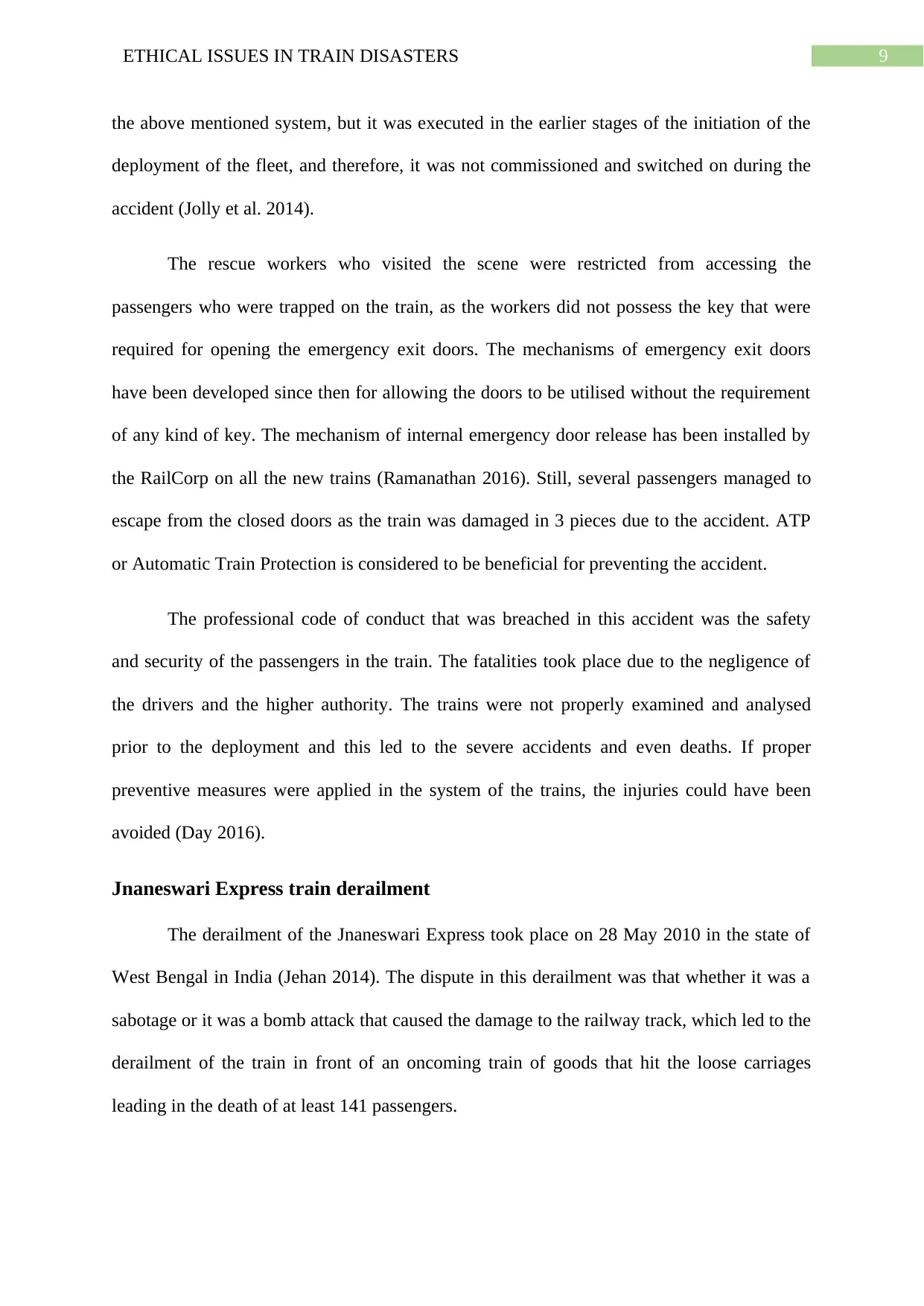
9ETHICAL ISSUES IN TRAIN DISASTERS
the above mentioned system, but it was executed in the earlier stages of the initiation of the
deployment of the fleet, and therefore, it was not commissioned and switched on during the
accident (Jolly et al. 2014).
The rescue workers who visited the scene were restricted from accessing the
passengers who were trapped on the train, as the workers did not possess the key that were
required for opening the emergency exit doors. The mechanisms of emergency exit doors
have been developed since then for allowing the doors to be utilised without the requirement
of any kind of key. The mechanism of internal emergency door release has been installed by
the RailCorp on all the new trains (Ramanathan 2016). Still, several passengers managed to
escape from the closed doors as the train was damaged in 3 pieces due to the accident. ATP
or Automatic Train Protection is considered to be beneficial for preventing the accident.
The professional code of conduct that was breached in this accident was the safety
and security of the passengers in the train. The fatalities took place due to the negligence of
the drivers and the higher authority. The trains were not properly examined and analysed
prior to the deployment and this led to the severe accidents and even deaths. If proper
preventive measures were applied in the system of the trains, the injuries could have been
avoided (Day 2016).
Jnaneswari Express train derailment
The derailment of the Jnaneswari Express took place on 28 May 2010 in the state of
West Bengal in India (Jehan 2014). The dispute in this derailment was that whether it was a
sabotage or it was a bomb attack that caused the damage to the railway track, which led to the
derailment of the train in front of an oncoming train of goods that hit the loose carriages
leading in the death of at least 141 passengers.
the above mentioned system, but it was executed in the earlier stages of the initiation of the
deployment of the fleet, and therefore, it was not commissioned and switched on during the
accident (Jolly et al. 2014).
The rescue workers who visited the scene were restricted from accessing the
passengers who were trapped on the train, as the workers did not possess the key that were
required for opening the emergency exit doors. The mechanisms of emergency exit doors
have been developed since then for allowing the doors to be utilised without the requirement
of any kind of key. The mechanism of internal emergency door release has been installed by
the RailCorp on all the new trains (Ramanathan 2016). Still, several passengers managed to
escape from the closed doors as the train was damaged in 3 pieces due to the accident. ATP
or Automatic Train Protection is considered to be beneficial for preventing the accident.
The professional code of conduct that was breached in this accident was the safety
and security of the passengers in the train. The fatalities took place due to the negligence of
the drivers and the higher authority. The trains were not properly examined and analysed
prior to the deployment and this led to the severe accidents and even deaths. If proper
preventive measures were applied in the system of the trains, the injuries could have been
avoided (Day 2016).
Jnaneswari Express train derailment
The derailment of the Jnaneswari Express took place on 28 May 2010 in the state of
West Bengal in India (Jehan 2014). The dispute in this derailment was that whether it was a
sabotage or it was a bomb attack that caused the damage to the railway track, which led to the
derailment of the train in front of an oncoming train of goods that hit the loose carriages
leading in the death of at least 141 passengers.
Paraphrase This Document
Need a fresh take? Get an instant paraphrase of this document with our AI Paraphraser
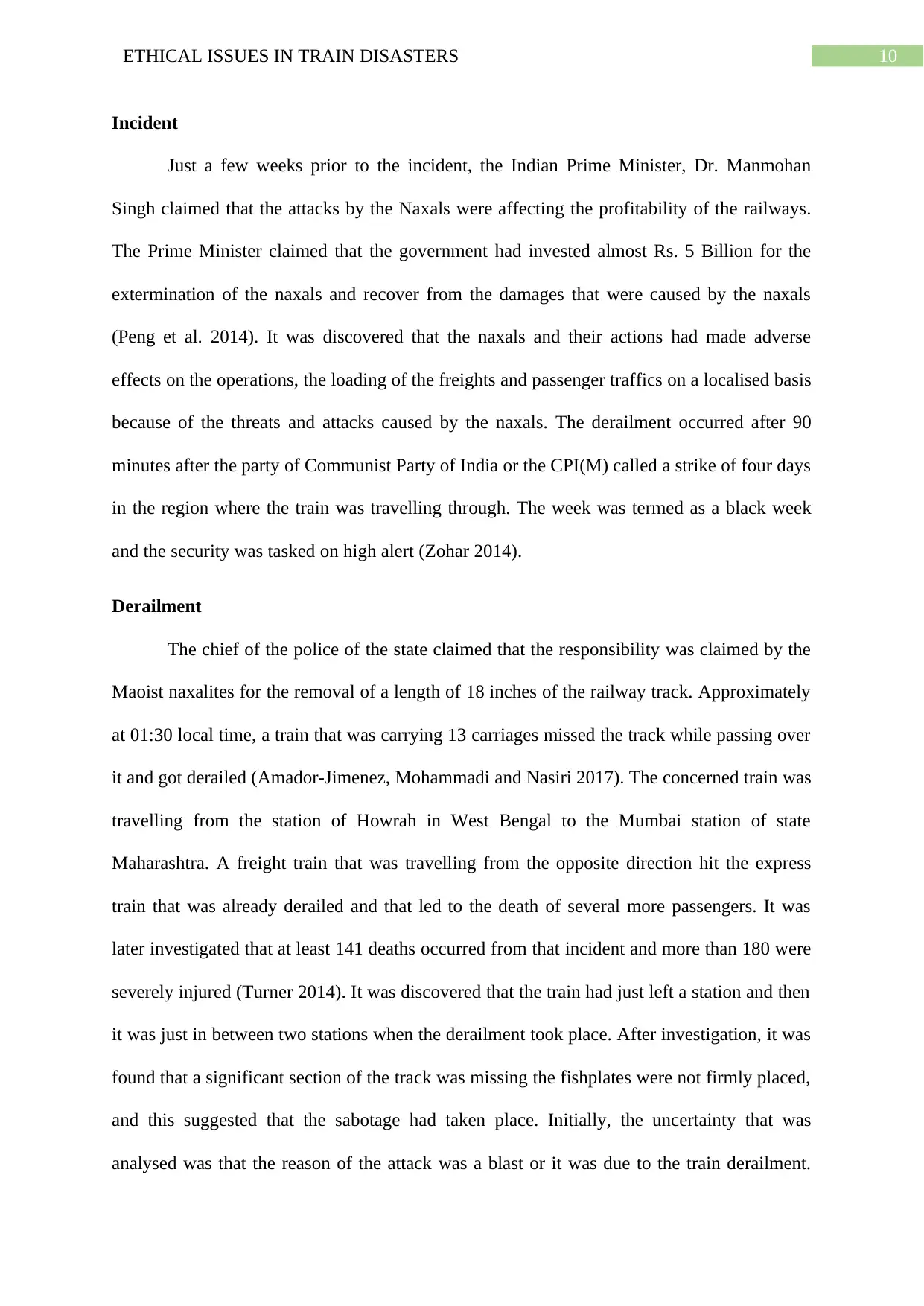
10ETHICAL ISSUES IN TRAIN DISASTERS
Incident
Just a few weeks prior to the incident, the Indian Prime Minister, Dr. Manmohan
Singh claimed that the attacks by the Naxals were affecting the profitability of the railways.
The Prime Minister claimed that the government had invested almost Rs. 5 Billion for the
extermination of the naxals and recover from the damages that were caused by the naxals
(Peng et al. 2014). It was discovered that the naxals and their actions had made adverse
effects on the operations, the loading of the freights and passenger traffics on a localised basis
because of the threats and attacks caused by the naxals. The derailment occurred after 90
minutes after the party of Communist Party of India or the CPI(M) called a strike of four days
in the region where the train was travelling through. The week was termed as a black week
and the security was tasked on high alert (Zohar 2014).
Derailment
The chief of the police of the state claimed that the responsibility was claimed by the
Maoist naxalites for the removal of a length of 18 inches of the railway track. Approximately
at 01:30 local time, a train that was carrying 13 carriages missed the track while passing over
it and got derailed (Amador-Jimenez, Mohammadi and Nasiri 2017). The concerned train was
travelling from the station of Howrah in West Bengal to the Mumbai station of state
Maharashtra. A freight train that was travelling from the opposite direction hit the express
train that was already derailed and that led to the death of several more passengers. It was
later investigated that at least 141 deaths occurred from that incident and more than 180 were
severely injured (Turner 2014). It was discovered that the train had just left a station and then
it was just in between two stations when the derailment took place. After investigation, it was
found that a significant section of the track was missing the fishplates were not firmly placed,
and this suggested that the sabotage had taken place. Initially, the uncertainty that was
analysed was that the reason of the attack was a blast or it was due to the train derailment.
Incident
Just a few weeks prior to the incident, the Indian Prime Minister, Dr. Manmohan
Singh claimed that the attacks by the Naxals were affecting the profitability of the railways.
The Prime Minister claimed that the government had invested almost Rs. 5 Billion for the
extermination of the naxals and recover from the damages that were caused by the naxals
(Peng et al. 2014). It was discovered that the naxals and their actions had made adverse
effects on the operations, the loading of the freights and passenger traffics on a localised basis
because of the threats and attacks caused by the naxals. The derailment occurred after 90
minutes after the party of Communist Party of India or the CPI(M) called a strike of four days
in the region where the train was travelling through. The week was termed as a black week
and the security was tasked on high alert (Zohar 2014).
Derailment
The chief of the police of the state claimed that the responsibility was claimed by the
Maoist naxalites for the removal of a length of 18 inches of the railway track. Approximately
at 01:30 local time, a train that was carrying 13 carriages missed the track while passing over
it and got derailed (Amador-Jimenez, Mohammadi and Nasiri 2017). The concerned train was
travelling from the station of Howrah in West Bengal to the Mumbai station of state
Maharashtra. A freight train that was travelling from the opposite direction hit the express
train that was already derailed and that led to the death of several more passengers. It was
later investigated that at least 141 deaths occurred from that incident and more than 180 were
severely injured (Turner 2014). It was discovered that the train had just left a station and then
it was just in between two stations when the derailment took place. After investigation, it was
found that a significant section of the track was missing the fishplates were not firmly placed,
and this suggested that the sabotage had taken place. Initially, the uncertainty that was
analysed was that the reason of the attack was a blast or it was due to the train derailment.
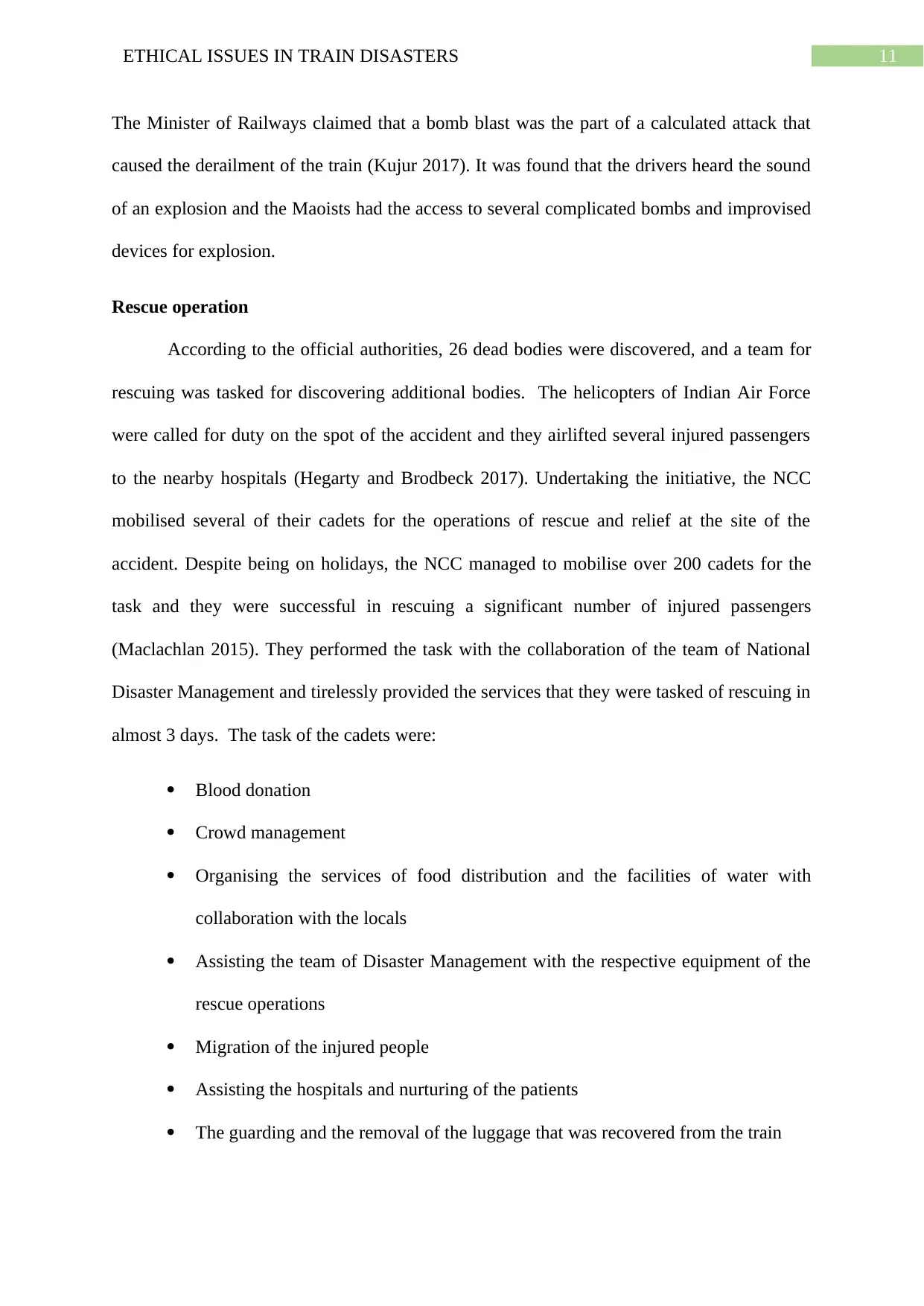
11ETHICAL ISSUES IN TRAIN DISASTERS
The Minister of Railways claimed that a bomb blast was the part of a calculated attack that
caused the derailment of the train (Kujur 2017). It was found that the drivers heard the sound
of an explosion and the Maoists had the access to several complicated bombs and improvised
devices for explosion.
Rescue operation
According to the official authorities, 26 dead bodies were discovered, and a team for
rescuing was tasked for discovering additional bodies. The helicopters of Indian Air Force
were called for duty on the spot of the accident and they airlifted several injured passengers
to the nearby hospitals (Hegarty and Brodbeck 2017). Undertaking the initiative, the NCC
mobilised several of their cadets for the operations of rescue and relief at the site of the
accident. Despite being on holidays, the NCC managed to mobilise over 200 cadets for the
task and they were successful in rescuing a significant number of injured passengers
(Maclachlan 2015). They performed the task with the collaboration of the team of National
Disaster Management and tirelessly provided the services that they were tasked of rescuing in
almost 3 days. The task of the cadets were:
Blood donation
Crowd management
Organising the services of food distribution and the facilities of water with
collaboration with the locals
Assisting the team of Disaster Management with the respective equipment of the
rescue operations
Migration of the injured people
Assisting the hospitals and nurturing of the patients
The guarding and the removal of the luggage that was recovered from the train
The Minister of Railways claimed that a bomb blast was the part of a calculated attack that
caused the derailment of the train (Kujur 2017). It was found that the drivers heard the sound
of an explosion and the Maoists had the access to several complicated bombs and improvised
devices for explosion.
Rescue operation
According to the official authorities, 26 dead bodies were discovered, and a team for
rescuing was tasked for discovering additional bodies. The helicopters of Indian Air Force
were called for duty on the spot of the accident and they airlifted several injured passengers
to the nearby hospitals (Hegarty and Brodbeck 2017). Undertaking the initiative, the NCC
mobilised several of their cadets for the operations of rescue and relief at the site of the
accident. Despite being on holidays, the NCC managed to mobilise over 200 cadets for the
task and they were successful in rescuing a significant number of injured passengers
(Maclachlan 2015). They performed the task with the collaboration of the team of National
Disaster Management and tirelessly provided the services that they were tasked of rescuing in
almost 3 days. The task of the cadets were:
Blood donation
Crowd management
Organising the services of food distribution and the facilities of water with
collaboration with the locals
Assisting the team of Disaster Management with the respective equipment of the
rescue operations
Migration of the injured people
Assisting the hospitals and nurturing of the patients
The guarding and the removal of the luggage that was recovered from the train
⊘ This is a preview!⊘
Do you want full access?
Subscribe today to unlock all pages.

Trusted by 1+ million students worldwide
1 out of 20
Related Documents
Your All-in-One AI-Powered Toolkit for Academic Success.
+13062052269
info@desklib.com
Available 24*7 on WhatsApp / Email
![[object Object]](/_next/static/media/star-bottom.7253800d.svg)
Unlock your academic potential
Copyright © 2020–2025 A2Z Services. All Rights Reserved. Developed and managed by ZUCOL.





